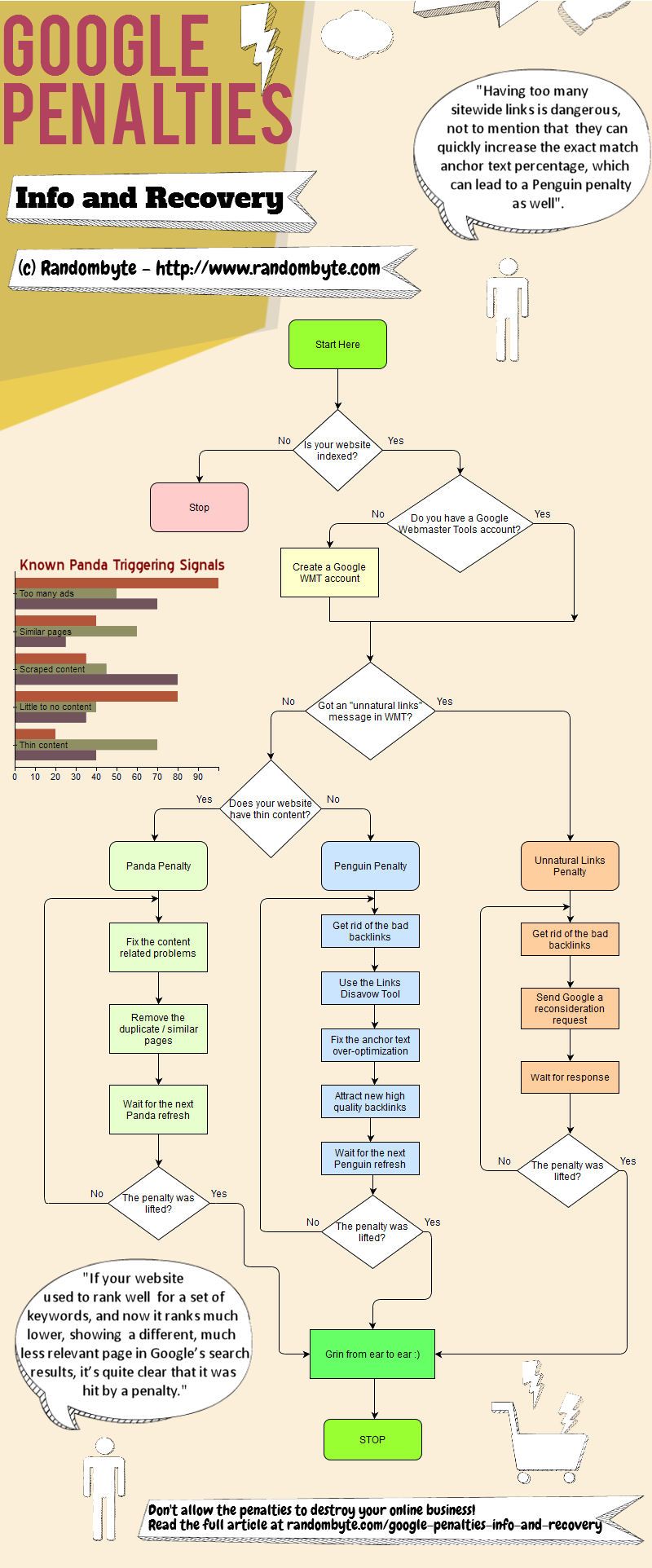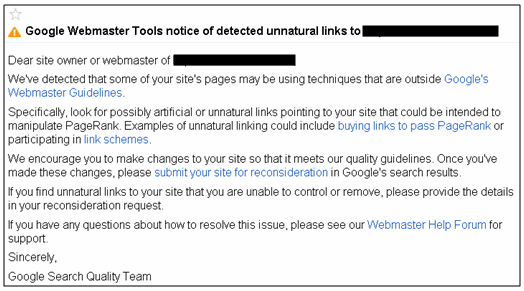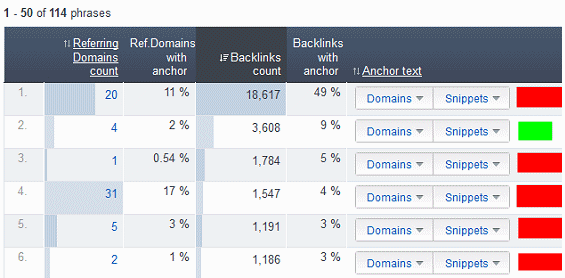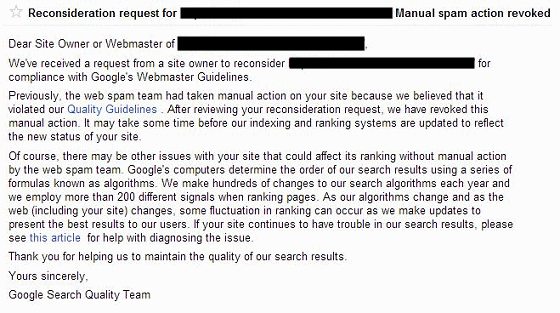
Google bases its ranking formula on the quality and quantity of backlinks pointing to a particular website. Other ranking signals include website content, layout, page loading speed, content freshness, and social signals, but backlinks are crucial for ranking on Google’s first page.
Previously, many consultants mastered search engine manipulation by keyword stuffing and building numerous low-quality backlinks, which search engines rewarded with high rankings.
However, the Panda/Farmer algorithm update disrupted this, penalizing websites with low-quality content and thin pages, causing significant ranking drops.
The Penguin update, launched on April 24, 2012, had an even more dramatic impact. It penalized websites over-optimizing their pages and engaging in spammy link-building techniques. While some innocent sites were affected, Google managed to clean up its search results once again.
Penguin targeted websites with manipulative backlinks, such as public blog networks and low-quality article marketing sites.
Let’s discuss the most important Google penalties.
1. The Unnatural Links / Manual Penalty

This is by far the most severe problem; it is a manual penalty applied by one of Google’s employees. While Panda and Penguin are algorithmic, the unnatural links penalty is applied by a person who has studied your website and its backlinks and found them to be shady. If you or an SEO consultant did some really spammy things, the website might even be deindexed, completely removed from Google’s index. It won’t show up in the search results no matter what you do.
Since a Google employee has applied the penalty, you will need to convince another Google employee to revoke it. Many manual investigations require quite a bit of human power, so they are often triggered when one of your competitors files a spam report, telling Google your website violates their webmaster guidelines.
Google’s spam reviewers monitor competitive money making niches, targeting websites that have unnatural linking profiles. Getting lots of backlinks in a short period of time may trigger a manual website review, which can lead to a manual penalty.
Want a real life example? Let’s assume that a website receives 100 visits per month; what are the odds of it getting 1,000 backlinks within a month?
The people working at Google have figured out how to identify many of the manipulative backlinking techniques. The algorithms they’ve created use machine learning, discovering new things by learning from existing data sets. Success rate is less than 100%, so a few innocent sites will get hit as well, but this is something we’ll have to live with.
2. The Penguin Penalty
A Google Penguin penalty is very similar to the unnatural links penalty. It is triggered by links coming from bad neighborhoods, unrelated websites, over optimized anchor text, etc. The good news is that these penalties are algorithmic, so they will be lifted automatically as soon as the negative factors that have caused them are gone. You won’t need the action of a Google web spam team member to revoke a Penguin penalty.
Google’s over optimization penalty appears when most of the backlinks pointing to your website have the same anchor text.
For example, if you wanted to rank high for “seo consulting”, all you needed to do was to create lots of links using “seo consulting” (exact match) as anchor text for your backlinks. Broad match anchor text keywords would include “seo services”, “website promotion consulting”, “search engine optimization” and so on, but most consultants used exact match.
Penguin changed that for good, lowering the allowed exact match anchor text percentage to less than 10%. And since many of the websites ranking on the first Google page had an exact match anchor text percentage of 90-95%, it’s easy to understand what happened.
The over optimization penalty is just one of Penguin’s spam fighting techniques; if your website gets lots of backlinks quickly, it will be penalized.
3. The Panda Penalty
This penalty affects the entire site most of the time. However, this duplicate content / thin content penalty can be lifted by rewriting the poor content and getting rid of pages that don’t provide value to visitors.
4. The EMD Update
What about the EMD (exact match domain) algorithm update? Basically, if you owned FreeSeoConsulting.com, the fact that it included the targeted keyword (free seo consulting) was helping it get higher rankings. Google launched the EMD update at the end of September 2012, significantly reducing the advantage provided by EMDs.
This is not a penalty, so there isn’t anything that you can do to fix it. Keep creating high quality content that attracts links and try to get backlinks from highly authoritative websites – that’s all you need to do in order to regain the good rankings your website had before the EMD update.
Page or Site Penalties?
No matter the penalty your site has gotten, it is important to know that the penalty can hit a single page or your entire website. If you want to make sure that it’s a page-level penalty, create a new page for a related keyword and see if it ranks well. In fact, most Penguin penalties are known to affect a single website page, but if this is the home page, your entire site is pretty much toasted, because most backlinks point to the home page anyway.
Penalty Recovery Step by Step
So how do you determine if your website has been penalized? Losing a few powerful links could lead to lower search engine rankings, which lead to significant website traffic losses. For example, if you used to rank #5 and you have gradually slipped to #12, it doesn’t mean that your website is penalized, but that your main competitors employ better SEO services.
Begin by verifying if your site can be found in Google’s index. Type “site:yoursite.com” into Google’s search box; there isn’t any space between the “site” operator, the colon and the actual domain name. If all is well, you will see the most important website pages in the search results.
Google shows that my website has a number of 89 web pages which can be found in its index; if you get a “your search did not match any documents” message for your website and its name was typed in correctly, your site was removed from Google’s index.
This will only happen when your site is a part of a blog network, a link wheel, gets links from public blog networks, etc. If your website gets deindexed, you probably know why it happened.
Google Unnatural Links / Manual Penalty Recovery
But let’s assume that the “site” operator has returned some results; this means the worst thing that could happen now is an unnatural links penalty. Do you have a Google Webmaster Tools account? It’s time to open one in case that you don’t have it, and then add your website to that account; if you have gotten a manual penalty, you will see a note that details it in the “All Messages” tab.
A competitor filing a spam report could also trigger a manual investigation of your site, followed by a manual penalty.
OK, so now you know that you have gotten an unnatural links penalty – what can you do about it? Unfortunately, a simple “I’m sorry! I won’t do it again” won’t be enough; Google wants to see that you have done everything in your power to clean up the mess before revoking the manual penalty.
Get rid of all the poor links, creating a spreadsheet that keeps track of all your efforts.
First, create a list which includes the links pointing to your website using your Webmaster Tools account and other tools like Majestic SEO, Open Site Explorer, etc. Merge the links from the individual lists into a single Excel spreadsheet, and then remove duplicate URLs to get the master backlinks list.
How to spot bad links
– First of all, review all the sitewide links; they are placed in the footer, blogroll, etc sections of a website. Not all of them are bad, but having too many of them is dangerous. Moreover, they can quickly increase the exact match anchor text percentage, which can lead to a Penguin penalty as well.
– Then, look for backlinks that have suspicious looking anchor text: medical products, red niches… you get the idea. These links weren’t built by you, I know, but this doesn’t mean that they don’t have to be deleted.
– Find poisonous links coming from sites belonging to public blog networks. Open each site and check its content; if it has hundreds or thousands of random posts using spun text and links out to all sorts of websites operating in various industries, you need to get rid of that link right away.
– Is one of the websites linking to you clearly selling links or engaging in reciprocal linking / link exchanges? Google doesn’t want to see it in your backlinks profile.
– What about the low quality links that come from thebestseodirectoryever.com and the like? They need do go as well.
– Sites that contain viruses, malware, spyware and other sorts of nasty things are considered to be (and they actually are) very dangerous, so try to get rid of all the links coming from them as quickly as possible.
– Did you pay somebody to build those 5,000 forum profiles for 20 bucks? They might have helped your website rank better several years ago, but now they’re hammering it.
– Blog commenting continues to be effective when it is done properly, but if you spam the web with “Great post!” comments on unrelated sites, linking back to your website, you are telling Google that you deserve to be slapped.
I could go on and on, but I think that you have gotten the idea: low quality links coming from unrelated sites have to go. It’s a time consuming process, because you have to contact the webmasters one by one, but that’s the only option you have if you want to get rid of a manual penalty. Sometimes you will be able to find a contact form or an email address on the website; if these contact methods aren’t available you can use a WHOIS service to get an email address that can be used to get in touch with the website owners.
Some of the webmasters will remove the link, others will ask money in exchange for the favor, and some of them will never reply to your emails. You should try and email each webmaster at least 2 or 3 times, writing down the date of each link removal request. Also, it is a wise move to set up a dedicated email account (use Gmail, Yahoo mail, etc) just for your link removal campaign; this way, you will have all the emails in a single, easily accessible place.
Tell the website owners that your site has been penalized by Google and that linking to a penalized site (your site) can get their sites penalized as well. Let them know that if they don’t respond to your email you will be forced to file a report which includes their site using the Disavow Links Tool (I’ll explain what this tool does below). Be polite, but firm – this will maximize your chances to have those links removed.
Don’t forget to document all your link removal efforts; it’s best to show the Google employee that you have done everything in your power to get rid of those spammy links.
Now that most of those bad links are removed, it’s time to use the Webmaster Tools account, sending Google a reconsideration request in which you detail all your link removal efforts and promise that you will never ever do such nasty things again. There is no need to send a reconsideration request for algorithmic penalties (Panda, Penguin and whatever other animals will be thrown at us in the future).
Since you may have removed some links that were actually helping, rather than hurting your site, it is wise to try and attract some fresh, high quality backlinks as well.
Penguin Penalty Symptoms
As you now know, a manual penalty can be easily identified. However, a Penguin penalty is much harder to detect because you won’t see any messages in your Webmaster Tools account. Nevertheless, there are several signs that can help you identify a Penguin penalty.
a) Sudden website traffic loss. If you haven’t installed Google Analytics on your website yet, it’s time to do it now. Don’t use GA if you are worried that you are giving away too much information, of course; there are many alternatives.
If your site was getting, on average, 50 visitors per day and all of the sudden the number has decreased to 5 visitors per day, it may have been hit with a Penguin penalty. Tools like Panguin are useful; they help you determine if the website traffic loss overlaps with one of the known Google algorithm updates.
b) Do you monitor keyword rankings on a regular basis? I have presented some useful tools in the 101 white hat seo tips article, so there isn’t any reason why you shouldn’t do that regularly. A sudden, significant ranking loss (jumping from 5 to 30+ for a particular keyword, for example) could indicate a Penguin penalty.
c) If you type your website’s domain name into Google’s search box, it should be listed as the first result on the first page. If you see other sites that link to your website ranking above you, the site has been penalized.
d) If your website used to rank well for a set of keywords and now it ranks much lower, showing a different, much less relevant page in Google’s search results, it was hit by a penalty. Type “your keyword site:yoursite.com” (without using the quotes) in Google’s search box; you should always see your website’s most relevant pages at the top of the search results.
Just take a look at the pages that Google considers to be relevant for “white hat seo” on Randombyte’s website; if I saw the “contact” page there, it would be quite clear that the site is penalized.
e) If you copy a long, unique phrase from one of your website pages and paste it into Google’s search box, your website should appear in the first few search results pages. If this doesn’t happen, it’s bad news for you.
f) If your website has a high percentage of exact match anchor texts, Penguin will hit it sooner or later. In fact, the most important Penguin penalty signal is the exact match anchor text percentage, which can show if a website has been optimized for SEO purposes or if it has gained its authority naturally.

Take a look at this anchor text profile; more than 73% of the anchors were targeting a particular keyword or slight variations of it. This site used to rank #1 for a competitive, two word SEO services related keyword, and now it can’t be found in Google’s top 100 anymore.
Penguin knows that normal people don’t link to your website using “seo consultant new york” all of the time; some might use “here’s a smart consultant”, others might use “ny website marketing ” and so on. By using lots of laser-targeted anchor text backlinks you are telling Google you have built them by yourself, so your site is going to get penalized.
Penguin Penalty Recovery
So how do you fix a Penguin penalty? First, identify and get rid of all the spammy links.
Then, get high quality backlinks from trustworthy websites through guest blogging, high quality content creation, and so on. Use the URL of your website and/or your company name/brand as anchor text for the newly created links, if you can control that.
Once your link profile is clean, the recovery process will start. It usually takes several months until the penalty is lifted.
Panda Penalty Symptoms
Most Panda penalties affect the entire site, leading to a sudden website traffic loss. If your site used to rank on the first Google search results page for several keywords and now it can’t be found on the first 3-5 pages, you might have been hit by a Panda penalty. If you have engaged in link buys and other spammy SEO techniques, your site might have gotten a Penguin penalty as well, but let’s assume that it’s only been hit by Panda for now. First, use the Panguin tool referenced above to determine if the traffic loss coincides with one of the known Panda updates.
If your website has duplicate content, or if it uses content available on other sites, it’s an ideal Panda candidate. If you have dozens or hundreds of 20… 200 words website pages, Google understands that your site doesn’t add too much value to the web.
Let’s consider a simple example: most E-commerce sites simply copy / paste the manufacturers’ product descriptions on their website pages, and this makes them ideal candidates for Panda penalties. The same thing goes for pages that were created for SEO purposes alone, without having a useful purpose. As an example, having several pages like “cheap-mens-watches”, “affordable-mens-watches” and “inexpensive-mens-watches” on your site tells Google that it’s time for a Panda penalty.
Having too many ads on your website shows you’re more interested in making a quick buck, rather than creating useful content for web surfers. And having big ads that push useful page content below the fold, making visitors scroll down in order to see the actual page content, is another Panda-triggering mistake.
Panda Penalty Recovery
Fortunately, websites hit by a Panda penalty are much easier to fix. The key penalty factor is low quality/duplicate content, so go through all the website pages one by one and rewrite them, ensuring they are meaty and useful. Get rid of pages that don’t provide value and/or merge several thin content pages into a meaty one.
Use canonical pages to tell Google what is the preferred version, if you really need to keep similar pages on your website. Fix broken links (internal and external) and add quality content to your website regularly.
Panda has been refreshed a few times per year until now, but since it’s going to be integrated into the regular search algorithm, penalty recoveries should be much faster in the future.
What About the Disavow Links Tool?
Sadly, Penguin has made it much easier to attack somebody else’s website, so you might get a penalty without doing anything wrong. Since Google is aware of this, it has created a tool which tells them what links they should ignore when it comes to ranking your website. Here’s a video from Matt Cutts, former head of web spam at Google, explaining how we are supposed to use the tool.
Should you use the disavow links tool if your website has been penalized? If you’ve gotten an unnatural links (manual) penalty, the disavow tool won’t be of help; Google wants to see that you’ve done a lot of work removing the bad links. They will check to see how many of the bad links on their list are still live before even thinking about lifting the manual penalty. So, do your best to remove as many links as possible and use the disavow tool for the rest.
If your site has been hit with a Penguin (algorithmic) penalty, the disavow links tool might help. Google has stated that this tool should only be used to help you get rid of the links you were unable to remove by contacting website owners. Try to get rid of as many bad links as you can, and then use the disavow tool for the others.
Don’t use the disavow tool to solve a Panda penalty; the site has been penalized because of its poor content, not because of its backlinks.
How long will it take until the penalty is lifted?
 If your website was hit with a manual penalty, you will need to wait for several weeks to receive a response to your reconsideration request. If you did your best, you may get some good news; otherwise, you will receive a message that encourages you to continue to clean up the backlinks profile. And if the penalty is revoked, rest assured that it’s the first and last time they’ll do you this favor.
If your website was hit with a manual penalty, you will need to wait for several weeks to receive a response to your reconsideration request. If you did your best, you may get some good news; otherwise, you will receive a message that encourages you to continue to clean up the backlinks profile. And if the penalty is revoked, rest assured that it’s the first and last time they’ll do you this favor.
Once that you have gotten the good news message, the penalty recovery process can take several weeks to several months – it won’t happen overnight. And if your site was also hit by a Penguin anchor text over optimization penalty, you’ll need to deal with that (and wait for a Penguin refresh) as well.
Does this article have an end?
I started to ask myself the same question a while ago, but it looks like after 5000+ words we’re finally coming close to an end. I have shared most of the things I know about penalties and recovery here, but the truth is that nobody can guarantee your website will recover. In fact, even if your website recovers, it might not regain its initial rankings because some of those spammy links that were actually helping it rank better are now removed.
However, I encourage you to use what you’ve learned in this article. That’s how I work, and I have helped several business owners get rid of penalties.
A piece of advice: Penguin is constantly learning to identify artificial link patterns and it’s got more and more data at its disposal each day. So, weigh the risks and decide if you want to create a site that can go down in flames anytime, or build a long term business online. Not only that, but Google fine tweaks its algorithm hundreds of times per year, so if you plan to engage in shady SEO techniques in the future, you’d better understand the risks prior to doing that.
Is your website penalized? Then by all means try and get the penalty lifted! Or, maybe it’s time to start a brand new site. Nobody can guarantee that a penalized website will regain its former rankings, so it’s best to be prepared for an unpleasant outcome too. In fact, you should start building a backup website today even if your current site is doing great; it is always better to have two traffic sources for your business.
Did you make it this far? If this is the case, I think that both of us need to be congratulated! And if you liked this article, feel free to share the love using one of the social media buttons; this will encourage me to write comprehensive digital marketing guides.

